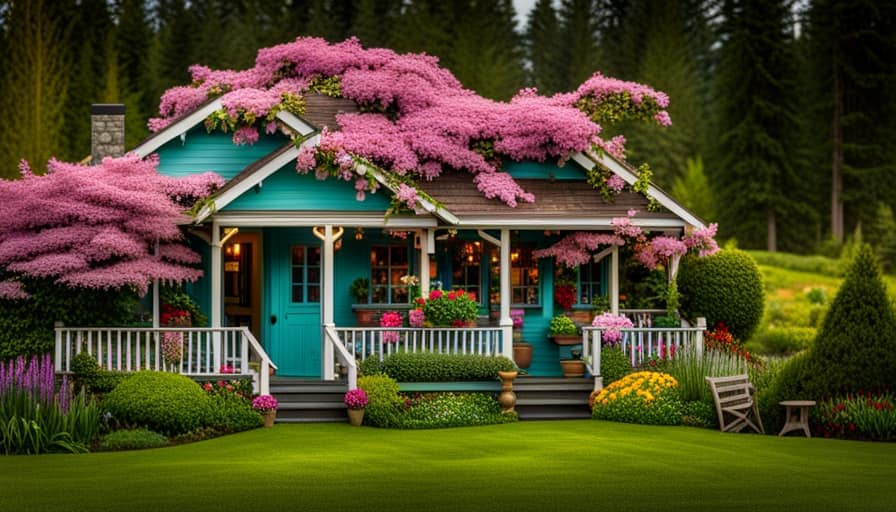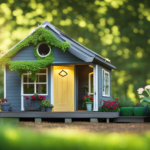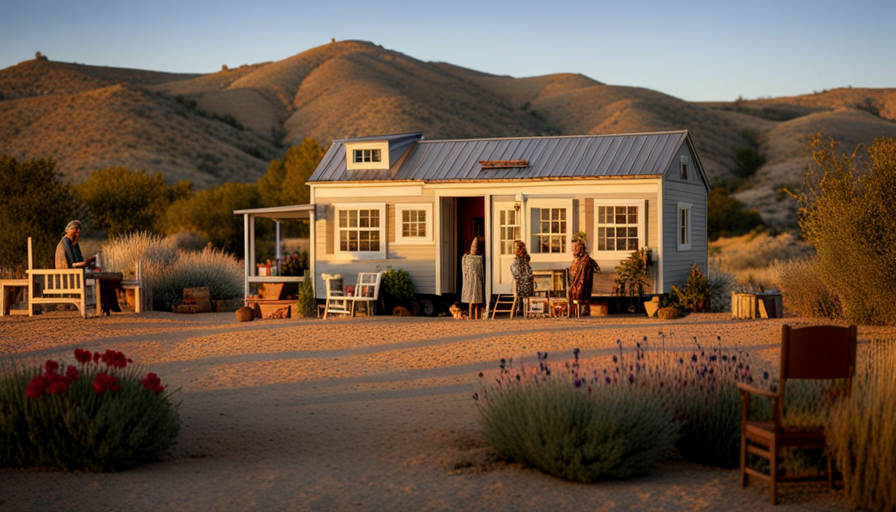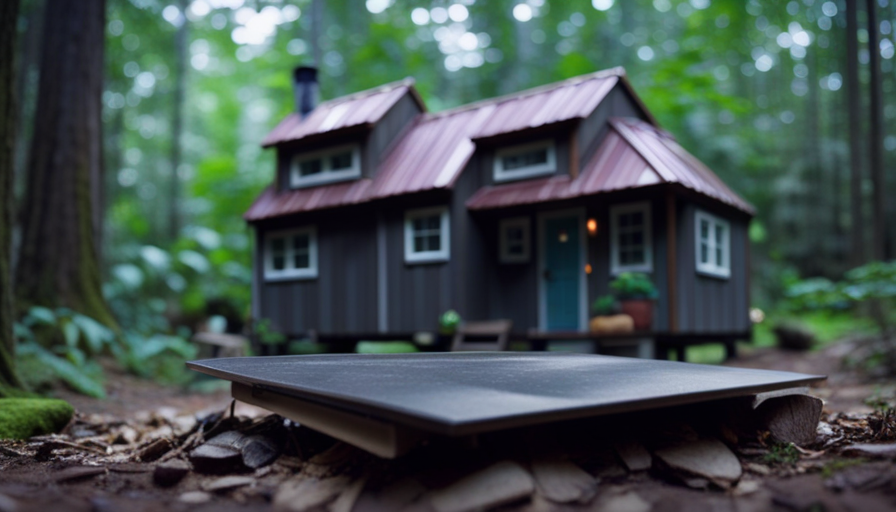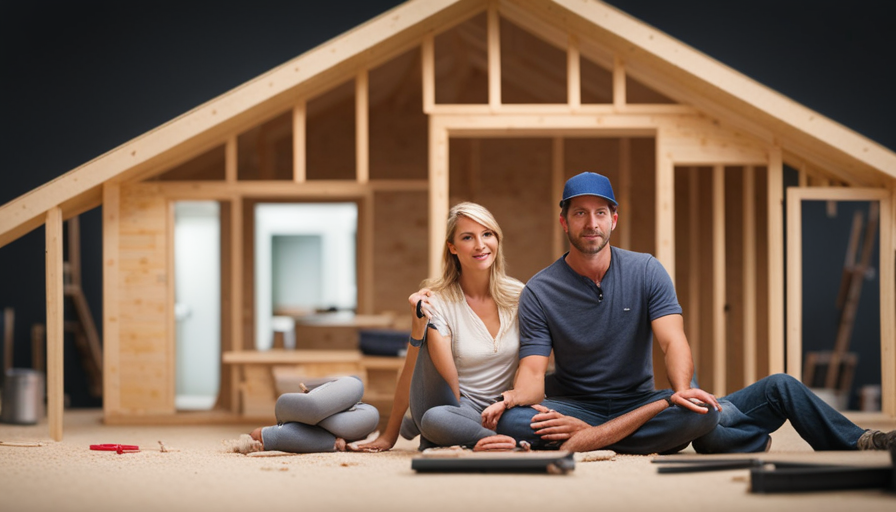We have discovered the ideal solution for individuals looking for eco-friendly living without compromising on style or comfort. Presenting the top 10 small homes that are redefining sustainability.
Take, for example, The Green Haven, a tiny home powered entirely by renewable energy. With recycled materials, off-grid capabilities, and a small footprint, these tiny homes are making a big impact on conserving resources and inspiring a greener future.
Get ready to be inspired by these eco-friendly havens that prioritize serving both the environment and its inhabitants.
Key Takeaways
- Space optimization: Tiny homes maximize space efficiency with multi-purpose areas and clever storage solutions.
- Energy efficiency: Due to their smaller size, tiny homes require less energy for heating, cooling, and powering, resulting in reduced energy consumption and lower utility bills.
- Minimalistic lifestyle: Living in a tiny home encourages a simpler and more minimalistic lifestyle, promoting conscious consumption and reducing waste.
- Reduced environmental footprint: Tiny homes help to reduce our carbon footprint and promote sustainable living by using fewer resources and producing fewer emissions.
The Green Haven: A Tiny Home Powered by Renewable Energy
We always strive to create a sustainable future, and The Green Haven is a tiny home that’s powered by renewable energy. This eco-friendly dwelling taps into renewable energy sources to provide a sustainable and efficient living space.

The Green Haven incorporates solar panels and wind turbines to harness the power of the sun and wind, reducing its reliance on traditional energy sources. Additionally, this tiny home is equipped with energy efficient appliances, further minimizing its carbon footprint.
By utilizing renewable energy sources and energy efficient appliances, The Green Haven sets an example for environmentally conscious living.
Now, let’s transition into the next section and take a closer look at the concept of sustainable simplicity within the eco-friendly tiny house movement.
Sustainable Simplicity: A Look Inside the Eco-Friendly Tiny House Movement
As enthusiasts of sustainable living, we find ourselves intrigued by the concept of sustainable simplicity within the eco-friendly tiny house movement.

This movement advocates for a minimalist lifestyle, where individuals choose to live in smaller, more efficient spaces that have a smaller environmental footprint. The appeal of the tiny house movement lies in its ability to provide a simpler, more intentional way of living.
By embracing a minimalist lifestyle, individuals are able to focus on what truly matters, reducing clutter and unnecessary material possessions.
Within these tiny houses, eco-friendly interiors are a key component. From using reclaimed and sustainable materials to incorporating energy-efficient appliances and systems, every aspect of the design is carefully considered to minimize environmental impact.
The result is a harmonious blend of functionality, style, and sustainability.

From Trash to Treasure: Recycled Materials Transforming Tiny Abodes
Using discarded materials and repurposed items, we transform ordinary trash into extraordinary treasures that bring character and sustainability to our tiny abodes. Through upcycling potential and creative construction techniques, we maximize the use of existing resources and minimize waste. Our commitment to sustainability goes beyond just using recycled materials; it is about reimagining their purpose and giving them a new lease on life.
To illustrate the ingenuity and variety of materials we use, here is a table showcasing some examples:
| Material | Upcycling Potential |
|---|---|
| Shipping containers | Converted into living spaces |
| Pallets | Transformed into furniture |
| Wine barrels | Repurposed as water storage |
Off-Grid Oasis: Tiny Cabins Embracing Self-Sufficiency
Our tiny cabins are equipped with solar panels, allowing us to embrace self-sufficiency and live off the grid. By implementing self-sustaining practices and utilizing renewable energy sources, we’ve created an off-grid oasis that promotes a sustainable way of living. Picture yourself in one of our tiny cabins, nestled in the midst of nature, with the following features:
-
Solar panels: Our cabins are powered by solar energy, harnessing the sun’s rays to generate electricity.
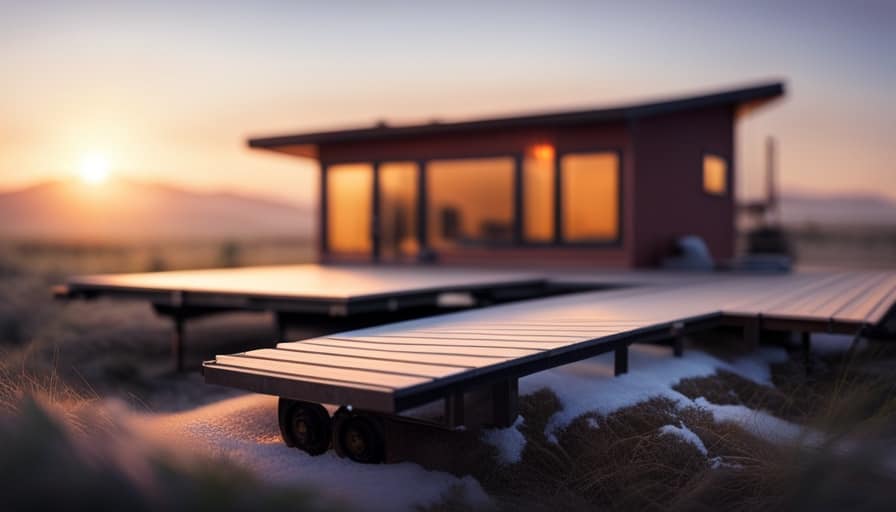
-
Rainwater collection system: We collect and filter rainwater, providing us with a sustainable water source.
-
Greywater recycling: We treat and reuse water from showers and sinks, minimizing waste and conserving resources.
Living off the grid in our tiny cabins allows us to reduce our environmental impact and preserve natural resources. Now, let’s explore how these small homes conserve resources and leave a big impact.
Small Footprint, Big Impact: How Tiny Homes Conserve Resources
The tiny homes in our eco-friendly revolution have a small footprint, but they make a big impact by conserving resources.
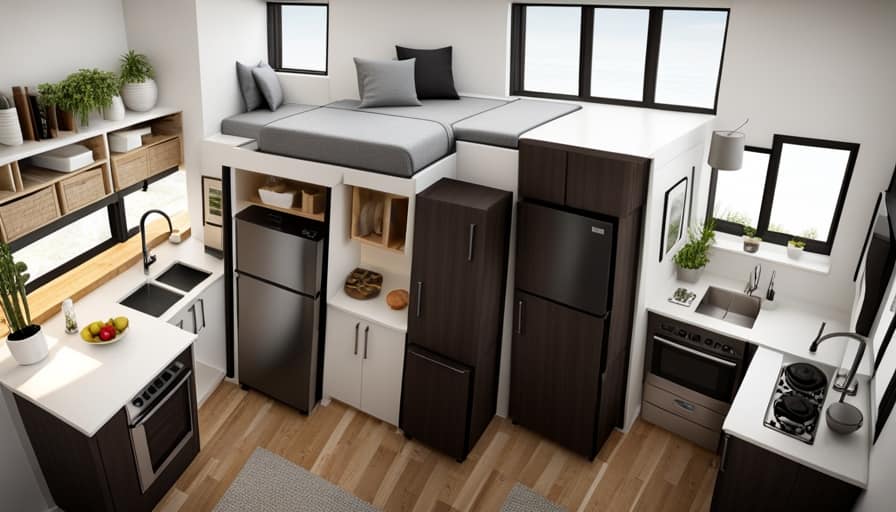
One of the ways they achieve this is by using energy efficient appliances. These appliances are designed to consume less energy, reducing the overall electricity usage in the tiny home. This not only helps the environment by decreasing the carbon footprint but also saves money for the homeowners in the long run.
Additionally, sustainable building materials are used in the construction of these tiny homes. These materials are sourced responsibly, ensuring that they’re renewable and have a minimal impact on the environment.
Innovative Designs for Minimal Living: Tiny Abodes Redefining Sustainability
We are constantly amazed by the innovative designs of these tiny abodes, redefining sustainability with their clever use of space and eco-friendly features. These tiny homes showcase the power of innovative architecture and sustainable materials in creating functional and environmentally-friendly living spaces.
Here are two examples that demonstrate this:

-
The Nest: This tiny abode features a unique design that resembles a bird’s nest, blending seamlessly with its natural surroundings. It utilizes sustainable materials like bamboo and reclaimed wood, reducing its environmental impact. The compact layout maximizes space efficiency, with clever storage solutions and multi-purpose furniture.
-
The Earthship: This innovative tiny home is built using recycled materials such as tires and glass bottles. It incorporates passive solar heating and cooling systems, reducing energy consumption. The earth-bermed walls provide natural insulation, minimizing the need for artificial heating or cooling. Additionally, it uses rainwater harvesting and greywater recycling systems, promoting water conservation.
These tiny abodes exemplify the possibilities of sustainable design, proving that living minimally doesn’t mean sacrificing comfort or style.
The Future Is Tiny: Sustainable Living in Compact Spaces
When it comes to sustainable living, tiny homes offer numerous benefits. These compact spaces not only require less land and materials to build, but they also consume less energy and produce fewer emissions.
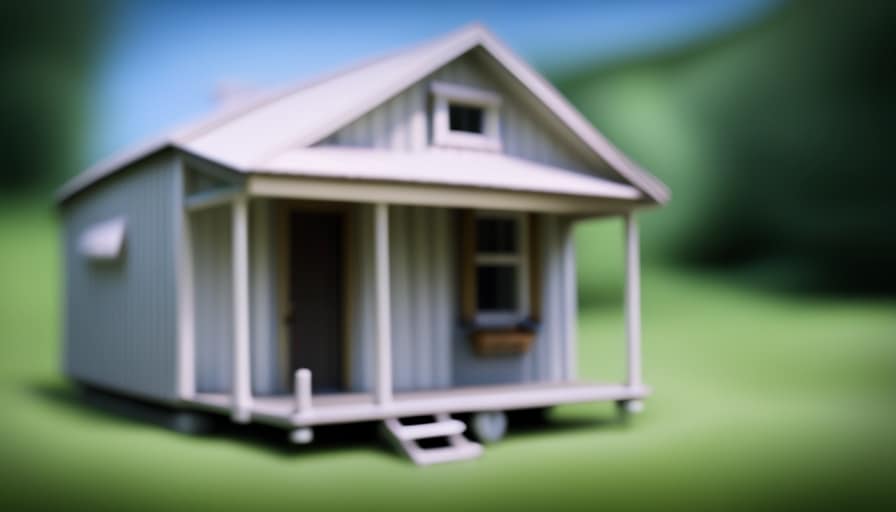
Innovative space-saving designs maximize efficiency and make the most out of limited square footage. By embracing tiny homes, individuals can significantly reduce their environmental footprint and contribute to a more sustainable future.
Benefits of Tiny Homes
One of the benefits of tiny homes is that they allow us to live in a more sustainable and compact space. With the increasing concern for our environment, living in eco-friendly homes has become a priority for many. Tiny homes provide a solution by reducing our carbon footprint and promoting sustainable living.
-
Space optimization: Despite their small size, tiny homes are designed to maximize space efficiency. Each area serves multiple purposes, ensuring that every inch is put to good use.
-
Energy efficiency: Tiny homes require less energy to heat, cool, and power, thanks to their smaller size. This results in reduced energy consumption and lower utility bills.
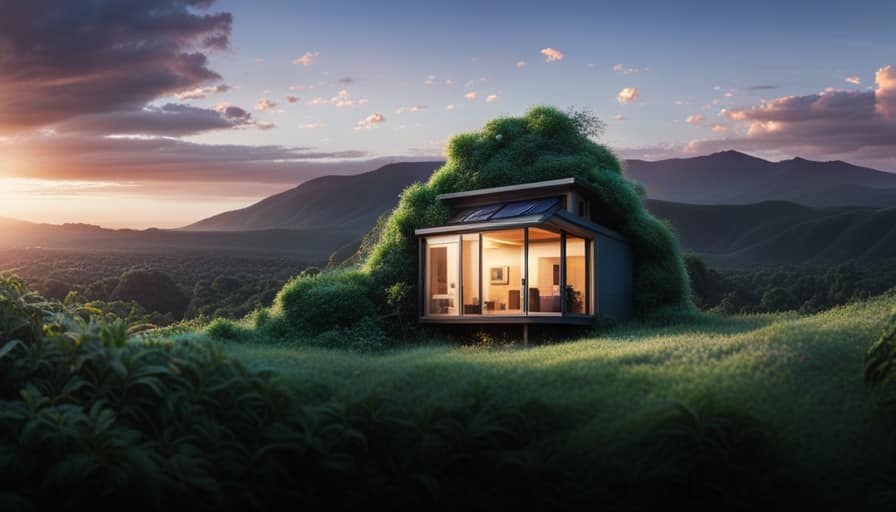
-
Minimalistic lifestyle: Living in a tiny home encourages a simpler and more minimalistic lifestyle. With limited space, homeowners are forced to prioritize their belongings and live with only what they truly need. This promotes conscious consumption and reduces waste.
Innovative Space-Saving Designs
With innovative space-saving designs, we can create compact and sustainable living spaces that optimize every inch of available area. Space saving furniture and innovative architecture play a crucial role in achieving this goal. These designs prioritize functionality and efficiency, ensuring that every piece of furniture serves multiple purposes and maximizes the use of limited space.
For example, a sofa that can transform into a bed or a dining table that can be folded against the wall when not in use. Innovative architecture also plays a key role in creating compact spaces that are both aesthetically pleasing and functional. Architects are now incorporating creative solutions like vertical gardens and multi-level structures to make the most of limited space.
These designs not only save space but also promote a sustainable and eco-friendly lifestyle. Transitioning into the next section, these innovative space-saving designs have a significant impact on reducing our environmental footprint.
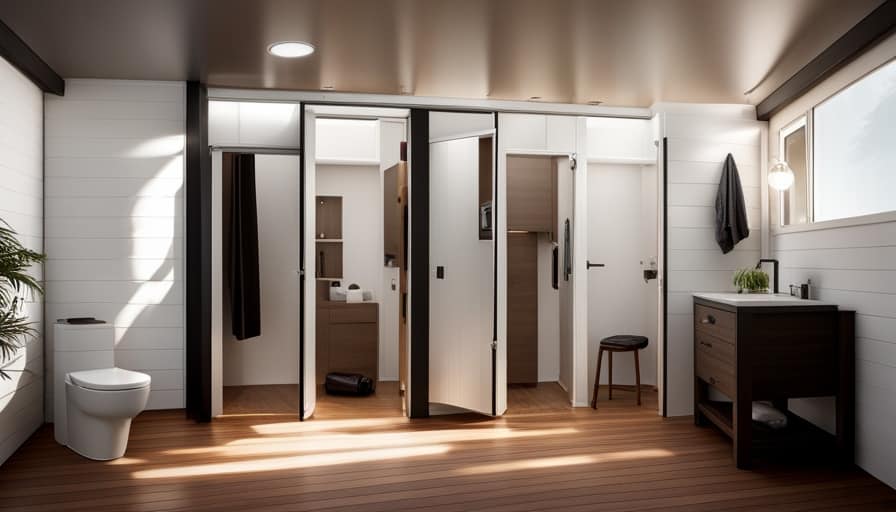
Impact on Environmental Footprint
Our tiny abodes not only reduce our environmental footprint, but they also promote a more sustainable way of living. With innovative space-saving designs and green solutions, these compact homes are making a significant impact on reducing our carbon footprint.
-
Efficient use of space: Tiny abodes are designed to maximize every inch of living space, minimizing the need for larger homes that consume more resources.
-
Energy-efficient features: These homes often incorporate energy-saving appliances, solar panels, and insulation, reducing energy consumption and reliance on fossil fuels.
Eco-Conscious Efficiency: Maximizing Comfort in Tiny Abodes
We can achieve optimal comfort in tiny abodes by incorporating innovative design elements and eco-conscious technologies. Maximizing efficiency is key to creating sustainable comfort in these small living spaces. By utilizing space-saving solutions and multifunctional furniture, we can make the most of every square foot.

For example, incorporating built-in storage options and modular furniture allows for easy organization and flexibility. Additionally, integrating natural light and ventilation systems reduces the need for artificial lighting and air conditioning, creating a more sustainable and comfortable living environment.
Smart home technologies can also play a role in maximizing efficiency by automating energy usage and optimizing temperature control. By combining these design elements and technologies, we can create tiny abodes that not only provide comfort but also minimize environmental impact.
Compact and Chic: Stylish Tiny Homes With Minimal Environmental Impact
The compact and chic tiny homes in this article showcase how minimal environmental impact can be achieved while still maintaining style and elegance. These homes are designed with minimalist aesthetics in mind, focusing on clean lines, open spaces, and a clutter-free environment. They utilize eco-friendly materials such as reclaimed wood, recycled metal, and sustainable bamboo flooring, further reducing their carbon footprint.
The use of large windows and skylights allows for ample natural light, reducing the need for artificial lighting and conserving energy. Additionally, these homes often incorporate innovative features such as rainwater harvesting systems, solar panels, and composting toilets, making them self-sufficient and reducing reliance on external resources.

With their sleek design and use of eco-friendly materials, these tiny homes prove that sustainable living can also be stylish.
Transitioning into the next section, let’s explore how these abodes are revolutionizing sustainable housing through their tiny living concept and inspiring design choices.
Tiny Living, Big Inspiration: How These Abodes Are Revolutionizing Sustainable Housing
By embracing the concept of tiny living, these abodes are revolutionizing sustainable housing and inspiring others to do the same. These innovative homes are designed to promote minimalist lifestyles while incorporating sustainable architecture. They serve as a model for how we can live comfortably and responsibly with a smaller ecological footprint.
To better understand the impact of these tiny abodes, let’s take a look at the table below:

| Abode | Size (sq. ft) | Materials Used | Energy Efficiency |
|---|---|---|---|
| The Tiny Retreat | 150 | Recycled wood | Solar panels |
| The Eco Pod | 200 | Bamboo | Rainwater system |
| The Green Haven | 250 | Straw bales | Geothermal heating |
| The Sustainable Hut | 180 | Clay bricks | Passive cooling |
These abodes showcase the endless possibilities of sustainable living. They use eco-friendly materials, implement renewable energy sources, and prioritize energy efficiency. By embracing this mindset, we can create a more sustainable future for ourselves and the planet.
Frequently Asked Questions
How Are Tiny Homes Powered by Renewable Energy?
Tiny homes are powered by renewable energy through the use of solar power and wind energy. These sustainable energy sources provide a clean and efficient way to meet the power needs of these compact living spaces.
What Is the Philosophy Behind the Eco-Friendly Tiny House Movement?
The philosophy behind the eco-friendly tiny house movement revolves around eco-friendly design principles and minimalist living. By embracing a simpler lifestyle and reducing our environmental footprint, we can contribute to a more sustainable future for all.
What Are Some Examples of Recycled Materials Used in the Construction of Tiny Homes?
Recycled materials for tiny homes are a key aspect of sustainable construction. Examples include reclaimed wood, recycled glass, and salvaged metal. These materials not only reduce waste but also contribute to the eco-friendly revolution.

How Do Off-Grid Tiny Cabins Achieve Self-Sufficiency?
Off-grid tiny cabins achieve self-sufficiency through innovative design and sustainable living techniques. By incorporating solar panels, rainwater harvesting systems, and composting toilets, these cabins minimize their environmental impact and provide a self-sustaining lifestyle.
What Are Some Ways in Which Tiny Homes Conserve Resources?
Water conservation and energy efficient design are key features of tiny homes. By incorporating low-flow fixtures, rainwater collection systems, and solar panels, these homes minimize their environmental impact and promote sustainability.
Conclusion
In conclusion, the tiny abodes featured in this article are like seeds of change, sprouting a green revolution in the world of sustainable living. These small homes, powered by renewable energy, constructed with recycled materials, and embracing self-sufficiency, are redefining what it means to live eco-consciously.
With their efficient use of resources and minimalist design, these tiny homes aren’t only minimizing our carbon footprint but also inspiring a new generation of sustainable housing. The future is indeed tiny, but its impact on our planet is colossal.

I’m Theodore, and I love tiny houses. In fact, I’m the author of Tiny House 43, a book about tiny houses that are also tree houses. I think they’re magical places where imaginations can run wild and adventures are just waiting to happen.
While tree houses are often associated with childhood, they can be the perfect adult retreat. They offer a cozy space to relax and unwind, surrounded by nature. And since they’re typically built on stilts or raised platforms, they offer stunning views that traditional homes simply can’t match.
If you’re looking for a unique and romantic getaway, a tree house tiny house might just be the perfect option.

